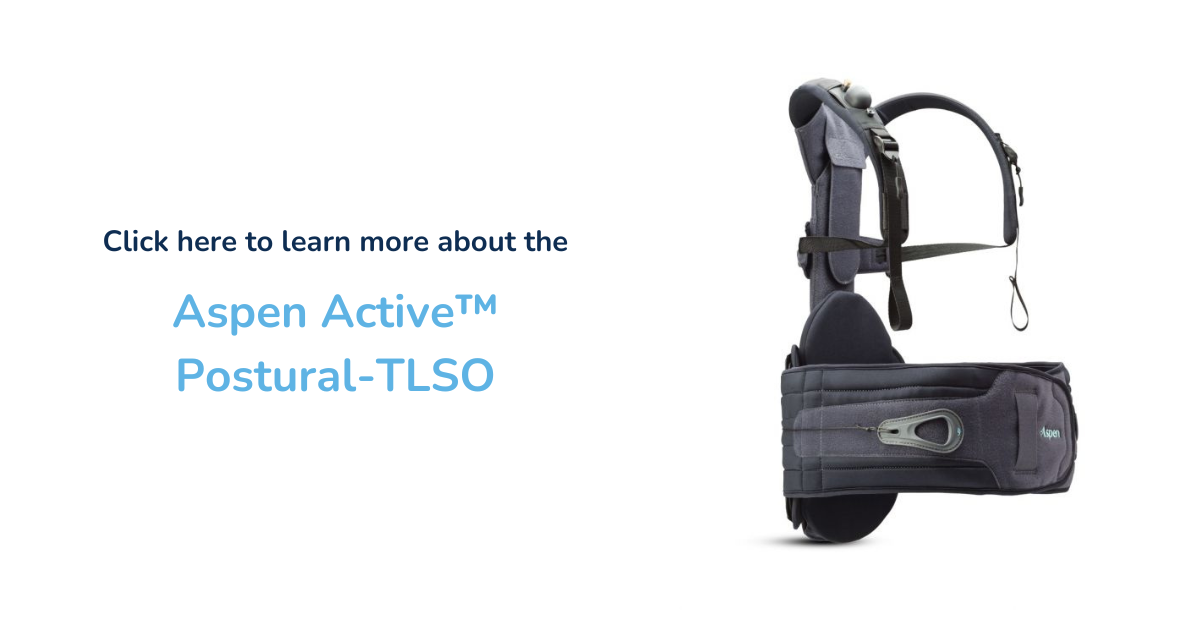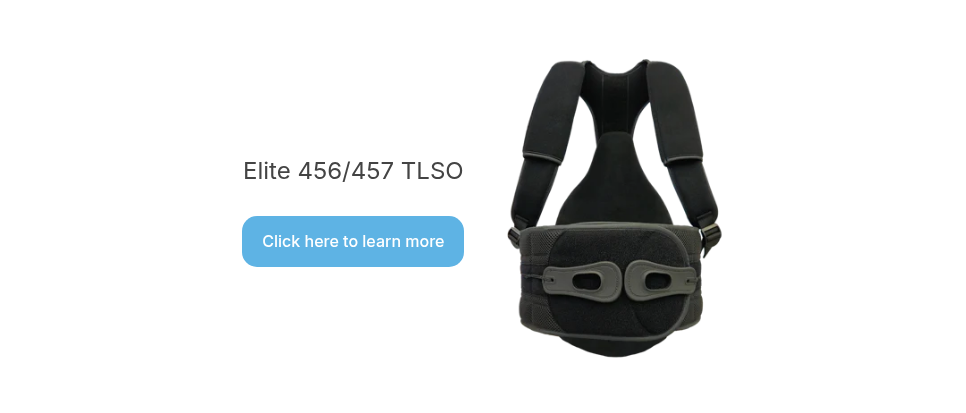Treating Kyphosis with a TLSO Brace
Kyphosis is a condition where the thoracic spine curves forward at an angle greater than 50 degrees. The medical term is hyperkyphosis but it is commonly referred to as kyphosis.
The greater the amount of forward curve determines the severity. A minor amount typically does not have many negative effects while a severe amount of curve can be painful and cause physical deformity.
There are braces designed to assist with the treatment of kyphosis. These braces are referred to as Thoracic-Lumbar-Sacral Orthosis (TLSO). We will explore kyphosis and the use of a TLSO brace during therapy in this blog article.

Types of Kyphosis
The three common types of kyphosis are postural kyphosis, Scheuermann’s kyphosis and congenital kyphosis.
Postural Kyphosis
Postural kyphosis does not usually result in pain or disfigurement. It is typically caused by poor posture or slouching in adolescents which results in a hunched over position. In adults, poor posture can cause an abnormal spinal curve but it is also attributed to other degenerative conditions such as osteoporosis.
A patient with postural kyphosis can stand erect, with or without assistance, straightening the thoracic spine to a normal position. This is referred to as a flexible curve of the spine.
The Aspen Active™ Postural-TLSO is a lightweight, adjustable brace designed to address the symptoms associated with poor posture often due to prolonged use of electronic devices/technology. While actively influencing a patient’s posture, the brace provides gentle support while activating postural stabilizing muscles. This product helps train the body to hold neutral posture by concurrently stretching and strengthening the structures that have become tight and deconditioned over time due to poor posture.
Scheuermann’s Kyphosis
This type of kyphosis can be severe and painful. Scheuermann’s Kyphosis is caused by the vertebrae having a wedge or trapezoid shape instead of the typical rectangular shape. The wedge shape forces the spine into a rounded shape because the vertebrae curve forward.
Areas of the spine with irregular shaped (wedge or trapezoid) vertebrae are inflexible. This results in a stiff spine with a hunch shape due to the angular curve. The lack of flexibility can be painful during activity, or when sitting/standing for an extended duration of time.
Scheuermann’s Kyphosis is named after the Danish radiologist who first described the condition.
.png?width=29168&height=11076&name=treating%20kyphosis%20with%20TLSO%20blog%20(2).png)
Congenital Kyphosis
Congenital kyphosis is present when a baby's spine forms incorrectly in the womb. The condition typically worsens over time with growth. Surgery may be elected to correct the condition at a young age but can become complicated at later stages of development.
Physical Exam
If you are experiencing some or all of the following symptoms it is advisable to see your doctor for a physical exam.
Symptoms:
- Abnormal thoracic curve or a hunched forward appearance
- Pain and stiffness in the upper thoracic region
- Loss of sensation
- Numbness, tingling, or weakness in the legs
- Shortness of breath
Your doctor will likely take a standing x-ray of the spine during your visit. This will assist them in determining if the thoracic spine has a forward curvature that exceeds the normal range. The measure of the spine curve can be determined from the x-ray assisting with a diagnosis. The x-ray can also show disc fractures, osteoporosis, or other degeneration which is contributing to the condition. A CT scan may be ordered which provides greater detailed images.
The Adam's forward bend test may also be used to diagnosis kyphosis by your doctor. This test is performed by bending forward at the waist with the feet together. When viewed from the side, your doctor can see the severity of spinal deformation. The test will show if the spinal curve is rounded or angular. A rounded curve is typically related to postural kyphosis while an angular curve is age-related or Scheuermann's kyphosis.
Part of your visit may include a nervous system exam. Your doctor will test your nervous system to determine if the severity is impacting parts of your nervous system. Tell your doctor if any parts of your body are painful, have a tingling sensation, become numb, or if you experience weakness.
Treatments
TLSO braces are used to correct the postural condition contributing to kyphosis. A TLSO brace places the user in an erect posture. This helps train users who have postural kyphosis what it feels like to have proper posture. The brace will be a physical reminder to remain erect and not slouch.
Over-The-Count (OTC) Nonsteroidal anti-inflammatory drugs (NSAID's) such as ibuprofen and aspirin may be recommended to help reduce pain. Consult with your doctor about what NSAID should be taken, the dosage, and duration.
While a TLSO brace will not permanently correct Scheuermann's kyphosis, it can aid in posture and halting further progression when used with physical therapy.
Selecting Your Brace
The team of experts at Elite Medical Supply is here to help identify the right brace for you. We offer a wide selection of TLSO braces for your kyphosis condition. Take a look at our selection of TLSO braces by clicking here and selecting the TLSO product type.
When you're ready to order a brace or need assistance making a choice we're here to help. You can reach us at 866-712-0881, send us an email, or fill out a contact form.
Written by Elite Medical Supply of NY
Braces and Products Covered by Medicare
Browse ProductsRecent Posts
- Spinal Decompression at Home: What It Is, How It Works, and Whether It’s Right for You
- Manage Osteoarthritis Progression With a Quality Knee Brace
- Product Highlight: Aspen Active™ P-TLSO
- Understanding Radiculopathy: Causes, Symptoms, & Treatment Options
- Alternatives to Back Surgery: What you Should Know
Topics
- Back Braces (39)
- Knee Braces (31)
- Medicare Beneficiaries (31)
- Pain (24)
- Non-Opioid (22)
- Medical Providers (19)
- Lower back pain (11)
- Product Highlight (11)
- Sciatica (11)
- Muscle Spasms (9)
- Decompression (8)
- Lumbago (8)
- Degenerative disc disease (6)
- Lumbar Spinal Stenosis (6)
- Spinal Stenosis (6)
- Working with your doctor (6)
- Fracture healing (5)
- Herniated Nucleus Pulposus (5)
- Bulging or herniated disc (4)
- Quadratus Lumborum Syndrome (4)
- SI Joint (4)
- SI Joint Dysfunction (4)
- Spondylolysis (4)
- Wrist Pain (4)
- Bone Growth Stimulator Therapy (3)
- Bone Growth Stimulators (3)
- Carpal Tunnel Syndrome (3)
- Neuromuscular Electrical Stimulation (NMES) (3)
- Unicompartmental Osteoarthritis (OA) (3)
- Wrist Brace (3)
- wrist tendinitis (3)
- Braces for Golf (2)
- Electrical Stimulation (2)
- Failed Spinal Fusion Syndrome (2)
- Kyphosis (2)
- Lumbar compression fractures (2)
- Radiculopathy (2)
- Spondylolisthesis (2)
- Supine Cervical Traction (2)
- Total Knee Replacement (2)
- Wrist Braces (2)
- Ambulatory Cervical Traction (1)
- Arthritis (1)
- Braces for skiing (1)
- Cervical Traction (1)
- De Quervain Syndrome (1)
- Digital DME Orders (1)
- Knee Brace Accessory (1)
- Knee Suspension Wrap (1)
- Knee brace support for skiing (1)
- Medicare Scam (1)
- Muscle Atrophy (1)
- PCL (1)
- Patellofemoral Pain Syndrome (1)
- TLSO (1)
- Ulnar Tendinitis (1)


